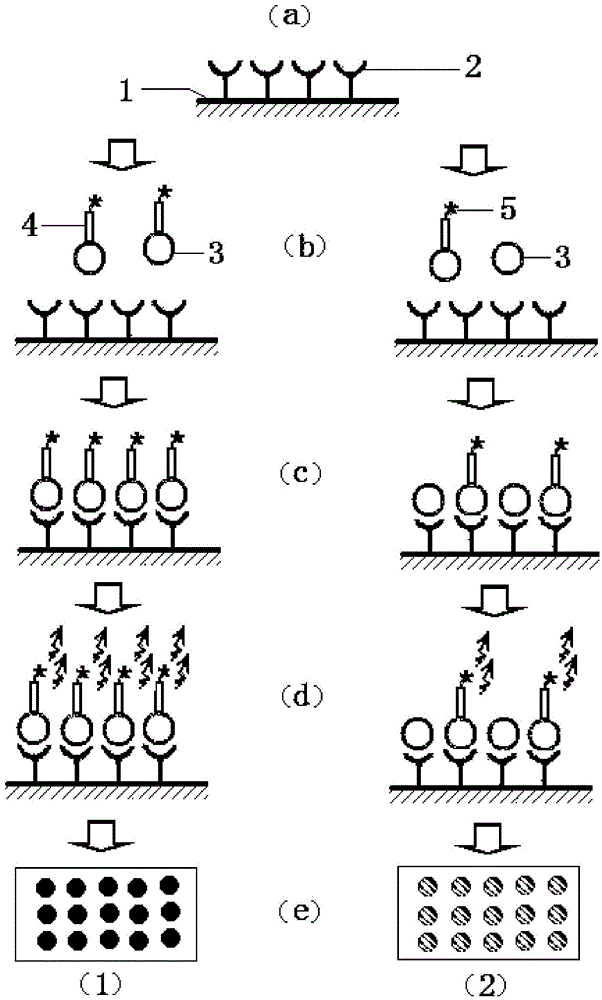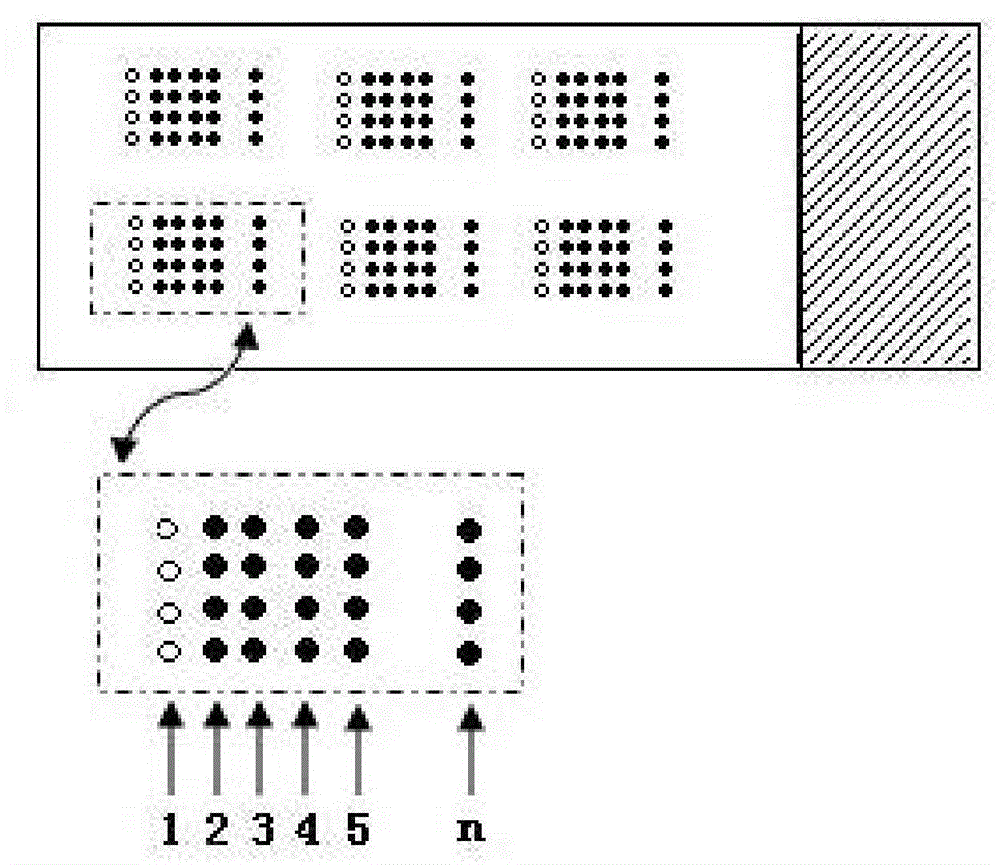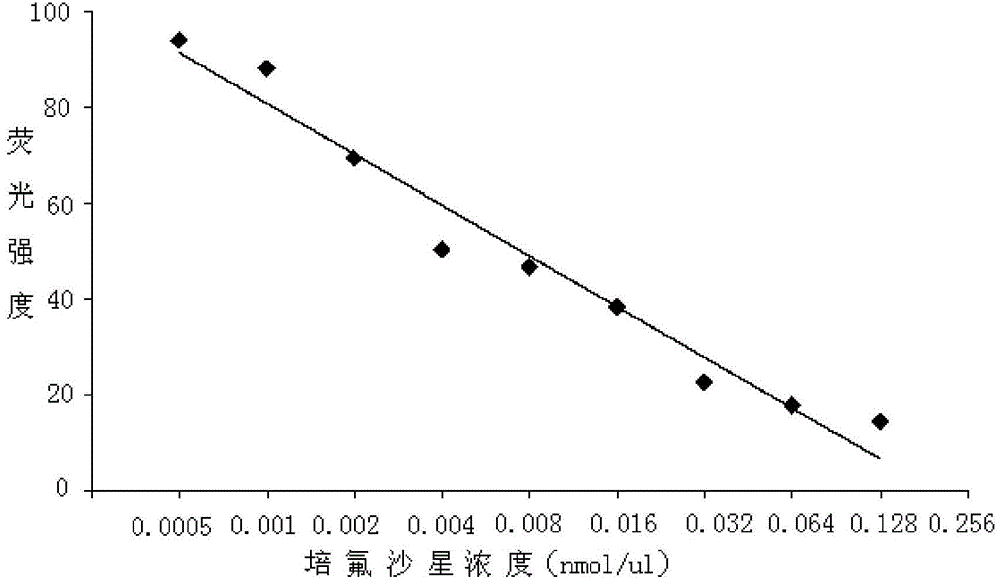Pesticide and veterinary drug multi-residue detection method based on microarray detection chip
A microarray chip and detection chip technology, applied in the direction of biological testing, material inspection products, etc., can solve the problems of expensive instruments, false positives, complicated and difficult operations, etc., to ensure accuracy and sensitivity, reduce preparation costs, and operate The effect of simple process
- Summary
- Abstract
- Description
- Claims
- Application Information
AI Technical Summary
Problems solved by technology
Method used
Image
Examples
Embodiment 1
[0066] Part I: Synthesis of Pefloxacin (PEFloxacion, PEF) Immunization Antigen and Detection Antigen
[0067] (1) Accurately weigh 45 mg of N-hydroxysuccinimide (NHS), 210 mg of carbodiimide (EDC), 36 mg of pefloxacin (PEF), and add 5 mL of N,N-dimethyl Formamide (DMF). And incubate at room temperature for 24 h with shading and stirring, and this solution is called A.
[0068] (2) Accurately weigh 105 mg bovine serum albumin (BSA), add 0.01 mol / L (pH 7.4) phosphate buffer saline (PBS) 15 mL, this solution is called B.
[0069] (3) Add the incubated solution A to solution B dropwise, stir while adding, and dialyze with 0.01 mol / L (pH value 7.4) PBS magnetic stirring for 6 days, and change the solution several times during the period to Remove unreacted small molecule species. Centrifuge at 12,000 r / min for 30 min, collect the supernatant to obtain the PEF-BSA conjugate, and store the obtained PEF-BSA conjugate in a -20°C refrigerator for future use.
[0070] After replaci...
Embodiment 2
[0138] The first part of melamine (Melamine) immune antigen and detection antigen synthesis
[0139] The immune antigen melamine-BSA and the detection antigen melamine-OVA were synthesized by combining polybasic anhydrides and mixed anhydrides.
[0140] (1) Synthesis of melamine glutaric anhydride semialdehyde by polybasic anhydride method (where pyridine is used as solvent and catalyst). Weigh 125 mg of melamine (about 1 mmol), add it into 4 mL of pyridine solution containing 114 mg (about 1 mmol) of glutaric anhydride, and stir the reaction with a magnetic stirrer for 22 h at room temperature. After the reaction was complete, the pyridine was blown dry with nitrogen.
[0141] (2) Use the above product to react with isobutyl chloroformate to obtain mixed anhydrides. Dissolve melamine-glutaric anhydride semialdehyde in 40 mL solvent (DMF and 1,4-dioxane 1:1 mixture), add 262 μL (about 1 mmol) n-tributylamine, stir in ice for 10 min, add chloroformic acid 144 μL (about 1 m...
Embodiment 3
[0148] The first part of the synthesis of methamidophos immune antigen and detection antigen
[0149] Weigh 100 mg of methamidophos and dissolve in 10 mL of 0.1 mol / L HCl, add pre-cooled 1 % NaNO 2 Continue to stir for 30 min until the starch potassium iodide test paper turns blue; take another 10 mg BSA and dissolve it in 2 mL of borate buffer solution with pH 8.7, take 2 mL of the above diazotization product and add it dropwise to the protein solution, and stir in an ice bath After 2 hours, place overnight at 4°C and put the reaction solution into a dialysis bag. Dialyze with PBS at 4°C for 3 days, freeze-dry the dialysate to obtain a white powder, store at -20°C for use. The coated antigen methamidophos-OVA was prepared in the same way.
[0150] The second part is the preparation of monoclonal antibodies to agricultural and veterinary drugs, and the third part is the preparation of microarrays of monoclonal antibodies to agricultural and veterinary drugs.
[0151] U...
PUM
 Login to View More
Login to View More Abstract
Description
Claims
Application Information
 Login to View More
Login to View More - R&D
- Intellectual Property
- Life Sciences
- Materials
- Tech Scout
- Unparalleled Data Quality
- Higher Quality Content
- 60% Fewer Hallucinations
Browse by: Latest US Patents, China's latest patents, Technical Efficacy Thesaurus, Application Domain, Technology Topic, Popular Technical Reports.
© 2025 PatSnap. All rights reserved.Legal|Privacy policy|Modern Slavery Act Transparency Statement|Sitemap|About US| Contact US: help@patsnap.com



